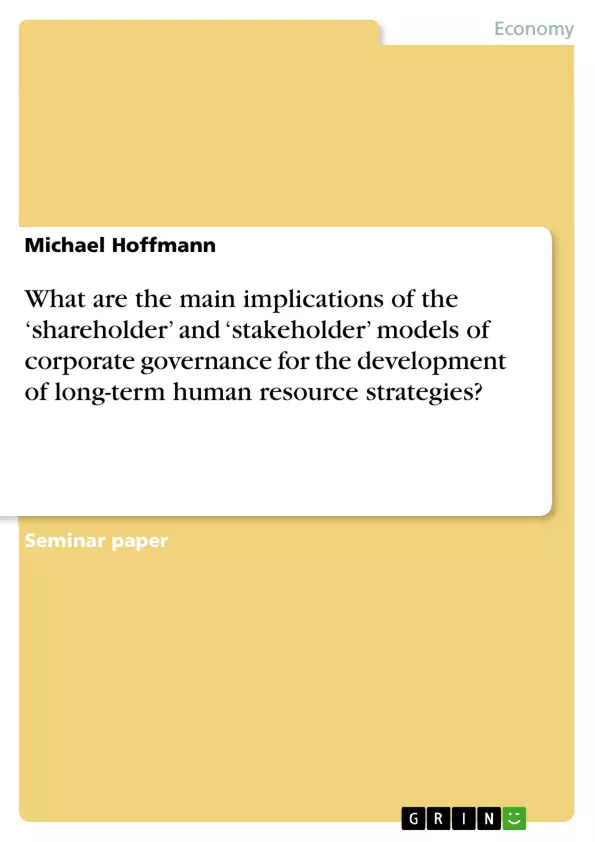The purpose of this essay is to point out how far a particular type of corporate governance determines human resource strategy and to what extent different HR strategies can be and are used in different systems of corporate governance. In this case the covered types of corporate governance are the ‘shareholder’ and the ‘stakeholder’ model. Generally, corporate governance is a matter of who owns the rights and the authority to make and influence companies’ decisions, which objectives are aligned and how it is controlled if executed decisions are together good ones. Corporate governance systems differ especially from the unequal role of shareholders and stakeholders, wherefore there exists the distinction between the ‘shareholder’ and the ‘stakeholder’ model of corporate governance. These differences have an important impact on the orientation of organizations’ HR-strategies, which are becoming more important for enhancing companies’ success. It suggests for this analysis to make a comparison between German and US corporations, which represent both a different type of corporate governance, as we are going to show. Before reviewing the implications concerning the specified above issue, first of all it is necessary to confront and define the main differences between the two mentioned models of corporate governance in Germany and the United States.
Table of Contents
- Introduction
- 'Shareholder' model vs. 'Stakeholder' model
- Impacts of differences in human resource strategies and policies
- Adaptability of long and short-term HR strategies in different types of corporate governance
Objectives and Key Themes
The primary objective of this essay is to explore the connection between corporate governance models and the development of long-term human resource strategies. The essay specifically examines the 'shareholder' and 'stakeholder' models and their implications for HR strategy in different contexts.
- Impact of corporate governance models on HR strategies
- Comparison of HR strategies in the 'shareholder' and 'stakeholder' models
- Adaptability of long-term HR strategies in short-term oriented environments
- Relationship between HR practices and shareholder value
- Influence of institutional frameworks and labor regulations on HR strategies
Chapter Summaries
- Introduction: This section defines the purpose of the essay and introduces the key concepts of corporate governance and human resource strategy. It highlights the differences between the 'shareholder' and 'stakeholder' models, emphasizing their impact on corporate decision-making.
- 'Shareholder' model vs. 'Stakeholder' model: This chapter contrasts the two models of corporate governance, exploring their underlying objectives, ownership structures, and strategic orientations. The 'shareholder' model, prevalent in the Anglo-American context, prioritizes shareholder value maximization, while the 'stakeholder' model, common in continental Europe, emphasizes a balance of interests among various stakeholder groups.
- Impacts of differences in human resource strategies and policies: This chapter examines the implications of the two corporate governance models for HR strategies. It explores the distinct HR practices and policies adopted by companies operating under the 'shareholder' and 'stakeholder' models, highlighting differences in employee relations, job security, compensation, and training investments.
- Adaptability of long and short-term HR strategies in different types of corporate governance: This section investigates the potential for adapting long-term HR strategies in short-term oriented environments and vice versa. It examines empirical evidence suggesting that high-performance work practices (HPWS), often associated with long-term HR strategies, can be successfully implemented in the short-term oriented US economy.
Keywords
Key concepts and terms explored in this essay include corporate governance, shareholder model, stakeholder model, human resource strategy, long-term employment, high-performance work practices (HPWS), employee relations, job security, compensation, training investments, shareholder value, institutional frameworks, and labor regulations.
- Quote paper
- Michael Hoffmann (Author), 2007, What are the main implications of the ‘shareholder’ and ‘stakeholder’ models of corporate governance for the development of long-term human resource strategies?, Munich, GRIN Verlag, https://www.grin.com/document/80065



